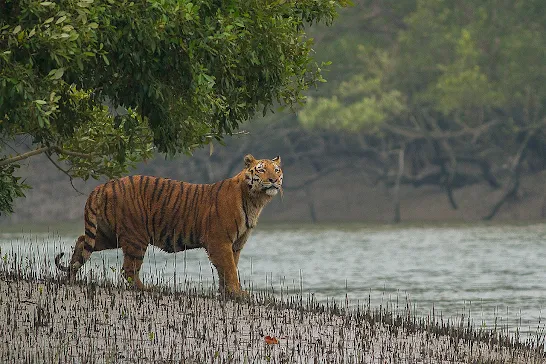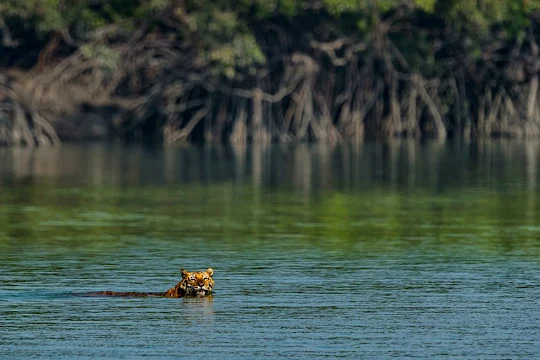Unveiling the Mysteries of the Sundarbans natural wonders of the world
Unveiling the Mysteries of the Sundarbans natural wonders of the world
The Sundarbans covers an area of approximately 10,000 square kilometers, making it the largest mangrove forest in the world. Nestled within the Indian state of West Bengal and the southwestern region of Bangladesh, it thrives in the brackish waters where the sea meets the land.
This expansive delta is an intricate network of tidal waterways, mudflats, and small islands created by the confluence of the Ganges, Brahmaputra, and Meghna rivers. The tides ebb and flow, shaping the landscape daily and nurturing an environment like no other. natural wonders of the world
Biodiversity at Its Pinnacle
1. The Royal Bengal Tiger: A Majestic Icon
The Sundarbans are world-renowned for their population of Royal Bengal Tigers, the largest tiger species in the world. These majestic creatures, skillful swimmers, have adapted to a semi-aquatic lifestyle. Their presence in the mangroves adds an aura of mystique to the region.
2. The Enigmatic Mangrove Forests
The Sundarbans are home to a unique ecosystem comprising numerous mangrove species, including the Sundari tree (Heritiera fomes), which lends the forest its name. These mangroves are specially adapted to thrive in brackish waters and serve as a vital buffer, protecting the land from coastal erosion and tsunamis. natural wonders of the world
3. Avian Wonders
The Sundarbans are a bird watcher's paradise. With over 300 bird species, including the endangered masked finfoot, it's a heaven for ornithologists. The dense foliage, extensive water bodies, and diverse prey options make it an ideal habitat for these feathered creatures.
4. Diverse Aquatic Life
The tidal waters of the Sundarbans support a rich aquatic life, from estuarine crocodiles to various fish and crustacean species. The mangroves serve as breeding grounds for many marine creatures, sustaining local fishing communities. natural wonders of the world
The Struggles and Challenges
1. Rising Sea Levels
The Sundarbans face a significant threat from climate change, with rising sea levels encroaching on the land. As a low-lying area, it's vulnerable to inundation, which could displace both human and wildlife populations. natural wonders of the world
2. Human-Wildlife Conflict
With a dense human population surrounding the Sundarbans, conflicts with wildlife, particularly tigers, are a growing concern. Finding ways for coexistence and mitigating these conflicts is an ongoing challenge.
3. Deforestation and Poaching
Illegal logging and poaching pose severe threats to the fragile ecosystem of the Sundarbans. Conservation efforts are essential to safeguard its biodiversity. natural wonders of the world
Conclusion
The Sundarbans, with its stunning biodiversity, unique ecosystem, and inherent challenges, stands as a testament to the marvels of the natural world. It is a place where the wild and the serene coexist in a delicate balance, showcasing the beauty and resilience of nature.
As you read about the Sundarbans, remember that while it is a place of wonder, it also requires our collective efforts for its preservation. Let us admire its beauty and work towards ensuring that this natural treasure remains for generations to come. natural wonders of the world.
A Natural Defense System
The Sundarbans serves as a natural defense system for the coastal regions of India and Bangladesh. The mangrove forests act as a barrier, reducing the impact of cyclones and storm surges. Without the protection offered by these mangroves, the damage caused by natural disasters could be far more severe. natural wonders of the world.
The Human Connection
The Sundarbans are not just a realm of wildlife; they are also inhabited by human communities. These communities, often referred to as "Mousuni" or "Sundarbans' people," have adapted to the unique challenges of living in this mangrove wilderness. They rely on fishing, honey collection, and farming for their livelihoods.
Flora and Fauna
The biodiversity in the Sundarbans is not limited to tigers and mangroves alone. It's also a habitat for saltwater crocodiles, Indian pythons, spotted deer, and many other species. The aquatic environment is teeming with fish, crabs, and shrimps, forming the basis of the food chain. natural wonders of the world.
Ecotourism
Tourism in the Sundarbans has gained popularity in recent years. Visitors come to witness the incredible wildlife, serene waterways, and the unique culture of the region. Ecotourism efforts aim to balance the economic benefits of tourism with the preservation of the fragile ecosystem. natural wonders of the world.
Conservation Initiatives
Various organizations and governments are actively involved in conservation efforts for the Sundarbans. These initiatives include anti-poaching measures, afforestation projects, and public awareness campaigns to safeguard this invaluable natural heritage.
Scientific Research
The Sundarbans also serve as a living laboratory for scientists studying climate change, mangrove ecology, and biodiversity. It's a place where researchers from around the world converge to better understand the complex interplay of ecosystems and climate. natural wonders of the world.
A Future Challenge
The future of the Sundarbans remains uncertain due to climate change and other environmental factors. Rising sea levels, increased salinity, and the loss of habitat are ongoing threats. Protecting this unique ecosystem is not just a local or regional concern but a global imperative.
In conclusion, the Sundarbans is a natural marvel that not only captivates with its beauty but also educates us about the importance of conserving and preserving our planet's biodiversity. It stands as a testament to the resilience of nature and the interdependence of life on Earth.









